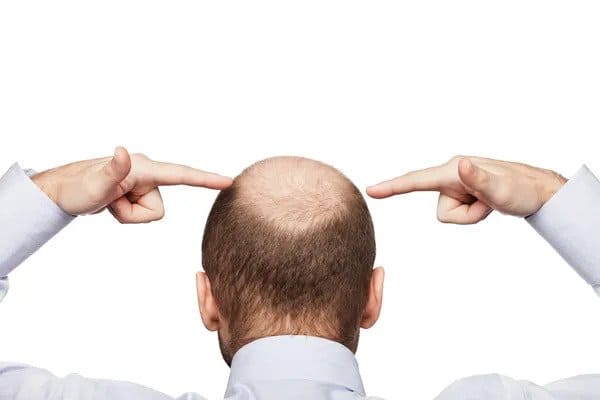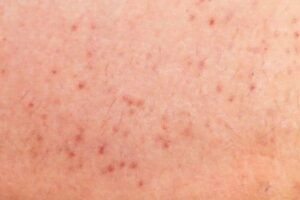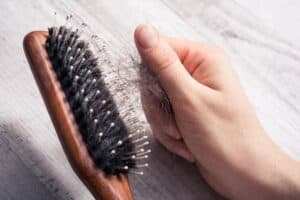If you’re suffering with hair loss and looking to stimulate hair growth, then you have probably wondered if there is a cure for baldness! On this page you will find everything you need to know about hair loss and baldness, from the origins of androgenetic alopecia to hair loss treatments (hair transplants and finasteride).
Overview
“Baldness” is a term for hair loss symptoms such as hair thinning and receding a hairline. Although there is no permanent cure for baldness, there are several hair loss treatments available to treat symptoms of balding like medication, injection treatments, and hair transplants.
What is Baldness?
Balding, also known as hair loss or alopecia, is a condition characterized by the partial or complete loss of hair, typically from the scalp. Balding can affect both men and women and can stem from a variety of genetic, hormonal, and environmental factors.

The most common type of balding is a condition called androgenetic alopecia (male pattern baldness and female pattern baldness). Androgenetic alopecia is a hereditary condition and is passed on through genetics on the mother’s side. Female pattern baldness is a similar condition that affects women.
However, when we use a term like “baldness”, we are typically talking about male patients who are suffering with quite extensive hair loss that is beginning to affect the crown area on the top of the head.
There are a number of different ways of treating hair loss (balding), including: minoxidil, finasteride, low level laser therapy, PRP treatments, and an FUE hair transplant.
How Does Baldness Occur?
Balding, or hair loss, is a complex process with several underlying scientific factors, and its precise cause can vary from person to person. If you are suffering with male pattern baldness, then your hair loss will largely be down to your genetic vulnerability and hormonal changes that occur.
Understanding the science behind balding is essential for developing effective treatments. So, keep reading the article below.
It’s in Your Genetic Makeup
Androgenetic alopecia, or male pattern baldness, is a hereditary condition that is a part of your genetic makeup. This is also the same for female pattern baldness.

Genes inherited from your parents can make you more susceptible to hair loss. These genes influence the sensitivity of hair follicles to dihydrotestosterone (DHT), a hormone that can shrink hair follicles and lead to hair thinning and eventual loss.
So, male pattern baldness does mean that you’re going to be more susceptible to hair loss from the outset, and that any other hormonal or environmental factors in your life may cause more male hair loss than those without male pattern baldness.
Ethnicity
Believe it or not, your ethnicitiy may even play a role in baldness and its causes. One study, conducted in 2023, found that white men were most likely to suffer with baldness when compared to other ethnic backgrounds.
If you may be genetically predisposed to a condition like balding, then it would certainly be wise to look into some medications or preventative treatments. This way you can stay on top of your hair thinning!
Biological Sex
Biological sex also seems to be a leading cause of hair loss. Pattern baldness appears to affect men much more than women, making it a lead cause of hair thinning.
Although women certainly do suffer with hair loss, they tend to suffer with temporary forms of hair loss, as opposed to pattern hair thinning. However, if a women also has the FPB gene, then environmental factors (like stress or hormonal changes) may further hair loss or pattern thinning.
Hormonal Changes
Hormones play a significant role in the regulation of hair growth. DHT, a byproduct of testosterone, can bind to androgen receptors on hair follicles in individuals with genetic predisposition, leading to the miniaturization of follicles and eventual hair loss.
In men and women, DHT tends to bind to the androgen receptors in your hair follicles in a patterned way. This means it’s easy to diagnose and monitor pattern baldness patients using the Hamilton-Norwood scale (for men) and the Ludwig Scale (for women).
Over time, in individuals with a genetic predisposition, hair follicles can become progressively smaller and produce thinner and shorter hairs. This process is called miniaturisation, and it eventually results in the cessation of hair growth in affected follicles.
Environmental factors
Environmental factors, such as exposure to pollutants, smoking, and a poor diet, can contribute to hair loss. Stress and inadequate nutrition can disrupt the hair growth cycle and lead to hair thinning and shedding.
What are the Leading Causes of Baldness?
Although male pattern baldness is, perhaps, the leading cause of baldness in men, there are a number of different conditions which can also cause hair loss. These include:
Alopecia Areata
Alopecia areata is an autoimmune condition where the body mistakingly sees your hair follicles are a foreign entity and removes these hair follicles. Although this form of hair loss is only temporary, it can be distressing for those who have it.
This alopecia will usually cause total baldness on the head or beard in the size of a 10p to 50p piece. Although a hair transplant is not an option for AA sufferers, hair loss medication may be something to consider, here, if you’re thinking of stimulating hair growth as quickly as possible.
Extreme Styling Practices
Certain hairstyles and hair treatments that put excessive stress on the hair, like tight braids or hair extensions, can lead to hair loss. Hairstyles such as braids or dreadlocks add excess weight on the hair follicle root, causing the follicle to rip out of the scalp.
Traction alopecia is a balding condition that would usually make a hair transplant a difficult option to pursue. Many patients with traction alopecia are usually recommended PRP or stem cells to help manage this condition.
Medications
Some medications, including chemotherapy drugs, can cause temporary or permanent hair loss as a side effect. As such, this can manifest itself as an appearance of baldness. If you think your hair loss may have occurred as a result of a treatment such as chemotherapy, feel free to book your free consultation today.
Why Do Balding People Look For Hair Loss Treatments?
It goes without saying that balding can have a significant impact on a person’s self-esteem and emotional well-being. If you can see your hair becoming visibly thinner over time, then it is no surprise that this could cause psychological issues.
While some forms of hair loss are permanent, others can be treated or managed with medications, lifestyle changes, or hair restoration procedures like hair transplants. So, hair loss treatments provide an avenue for maintaining hair growth and keeping our hair happy and healthy.
If you’re thinking about taking medication or treating your hair loss, it’s essential to consult with a healthcare professional or hair transplant surgeon to determine the underlying cause of your hair loss and explore potential treatment options. You can do this by booking your free consultation with us today!
Is There a Cure For Baldness?
With all of the causes and symptoms of balding now covered, the question still stands as to if there is there a cure for baldness? Well, the answer isn’t quite that simple.
The word “cure” implies that there is going to be one hair loss treatment or medication that is going to stop your hair loss for good, leaving you with luscious and thick hair for the rest of your life.
The reality is, this is simply not the case. Hair loss medication or treatment is going to, at the very least, manage your hair loss symptoms. If you’re considering a hair transplant to treat your baldness, then you may have a result that will provide long term results for between 10 to 15 years. However, it’s still not a “cure” for good.
Another problem with finding a “cure” for baldness is that there are so many causes, it makes it impossible to find a permanent cure! If you don’t know what is causing balding, it makes it difficult to find that magical potion that is going to get rid of your hair thinning for good.
With all this being said, scientific evidence and clinical trials have shown a range of different medications and treatments to be greatly effective at reducing hair loss symptoms and increase hair growth of hair follicles on the scalp.
We have devised this handy list, from least effective to most effective balding treatments, to help you separate the wheat form the chaff, and work out what measures you need to take to reverse hair loss!
DHT Blocking Shampoos
Perhaps the least invasive medication you can take to treat your baldness is a DHT blocking shampoo. DHT blocking shampoos look to prevent the hormone from DHT binding to the androgen receptors on your hair follicles, helping tackle thinning hair and maintaining hair growth.
However, one drawback to using DHT blocking shampoos as a treatment for managing your baldness symptoms is that there is a lack of scientific evidence to support this treatment, in comparison to oral DHT blocking medications such as finasteride and dutasteride.
Of course, there is no harm in using a DHT blocking shampoo. However, if you’re looking to maximise hair regrowth, we would personally recommend looking into oral treatments as they tend to be cheaper and more convenient for patients who are balding
Topical Medication
Simply put, a topical treatment is a foam or serum that is rubbed into the scalp and absorbed by your hair follicle cells to maintain hair growth. Topical medications can either be pharmaceutical or natural, but clinical research does look promising for topical hair loss treatments.
Topical Minoxidil
Topical Minoxidil is a foam that hair loss sufferers can take to treat baldness conditions such as male pattern hair loss, traction alopecia, and retrograde alopecia. Although Minoxidil is not a cure for baldness, minoxidil oe shelp to increase blood flow across the scalp, making sure your hair follicles receive all the nutrients they need.
Rosemary Oil
Rosemary oil is a popular natural remedy that is often claimed to have benefits for hair health, including potentially preventing hair loss and promoting hair growth. Although this is another hair loss cure based on shaky evidence, rosemary oil can help to maintain healthy hair.
While there is some anecdotal evidence and a few small studies to support these claims, it’s essential to understand that the scientific evidence on the effectiveness of rosemary oil for hair loss prevention is somewhat limited, and more research is needed to establish conclusive results.
Prescription Medication
Prescription medications like finasteride and dutasteride are largely DHT blocking medications. These medications have decades of clinical research put into them, and are perhaps the best hair loss treatment, pound for pound, you can use to treat hair loss.

These medications will help to stabilise your balding, making them ideal for patients in early stage sof balding, and those who have had a hair transplant.
Finasteride
Finasteride is a medical treatment, prescribed by doctors, for patients suffering with hair loss and balding. Finasteride is a great preventative measure that hair loss patients can take if they are worried about worried about male pattern hair loss.
Finasteride blocks an enzyme in your body called 5-alpha-reductase. This pesky enzyme lives inside your body and turns your body’s testosterone into another hormone called dihydrotestosterone (DHT). In turn, this stops you from losing hair on your hairline and scalp.
Dutasteride
Like finasteride, dutasteride is a medication affecting your body’s dht levels. In 90% of cases, dutasteride will need to be prescribed by a doctor or GP as it is stronger and more effective than finasteride.
Laser Treatments
Laser treatments, sometimes called low level laser therapy (LLLT), is a non-invasive treatment that has been explored as a potential option for managing hair loss, particularly in patients with androgenic alopecia (male or female pattern hair loss).
LLLT caps work through the use of low-level lasers or light-emitting diodes to stimulate hair follicles and promote human hair growth.
While some evidence suggests LLLT caps may have a positive effect on hair loss, the results are often mixed, and the treatment’s effectiveness varies from person to person. So, once again, it may be best to er on the side of cation with these hair loss treatments.
Injection Treatments
PRP Therapy
Platelet Rich Plasma (PRP) Therapy is an injection based hair loss treatment that is most effective for patients suffering with a general thinning of the hairline and/or crown. It works by increasing the blood flow around the scalp and plasma levels around the scalp, extending the hair cycle of your hair follicles and preventing hair loss.
PRP is also a great treatment that can be used in conjunction with a hair transplant to prevent hair loss from occurring post treatment. In the initial 12 months after a hair transplant, PRP can help to bolster and thicken your hair follicles, making them more resistant against balding in the future.
Stem Cell Treatments
Stem cell therapy is an emerging area of research and treatment in the field of hair restoration and hair loss. It’s important to note that stem cell treatments are not yet FDA approved medications and so consultation with a medical professional is a must before you engage with stem cell reservoir treatment.
Results for stem cell treatments hold promise for potentially helping to prevent or treat balding and hair loss, particularly androgenetic alopecia (male or female pattern baldness). However, it’s important to note that the science and clinical applications of stem cell therapy for hair loss are still in the early stages, and more research is needed to fully understand its safety and efficacy.
So, once again, it may be better to consider a more well established injection treatment such as PRP or Minoxidil and micro-needling if you’re looking at combatting hair loss and growing hair.
Hair Transplants
Perhaps the closest we will ever get to a “permanent cure” for baldness, the hair transplant enables patients to regrow hair in areas where extensive signs of thinning hair, balding, and recession have taken place, making them the perfect long term treatment.
When combined with finasteride or PRP treatments to prevent hair loss from occurring in the future, making this combination nearly a cure for baldness. So, what hair transplant methods are on offer?
Follicular Unit Extraction
An FUE hair transplant is one of the most popular hair transplant methods available today. This treatment looks to take hair from the back of your head, taking each hair follicle individually, and implanting them into the area you are suffering with baldness.
Follicular Unit Transplantation
The FUT method, sometimes called “strip surgery”, is the first hair transplantation method developed in the 1970s. This looks to excise a strip of skin from the back of the head, taking the hair follicles and, again, implanting them into your balding area.
One downside of this treatment is that it does leave a lifelong linear scar on the back of a patient’s head, which is not the case with DHI or FUE. So, if you’re looking for a semi-permanent cure for baldness, this is definitely something to consider.
Direct Hair Implantation
The DHI method is the newest hair transplantation method available for patients today. Similar to FUE, DHI looks to take hair follicles from the back of the head, individually, and implant them into the area you are suffering with hair loss.
The main difference between FUE and DHI, is that DHI boasts a shorter surgery time, recovery time, and a slightly higher efficacy of result. This makes it the perfect treatment if you’re looking to combat hair loss.








